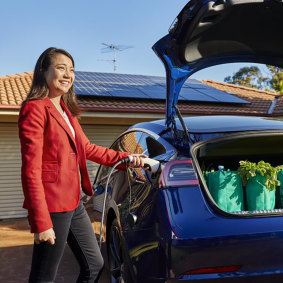

Origin’s head of e-mobility, Chau Le, says electric vehicle fleets require more co-ordination than petrol-run fleets.Credit:
These include the middle of the night when demand is lowest, or the middle of the day when there is more solar in the grid.
Some in the industry, looking even further ahead, are in early trials of “vehicle-to-grid” technology – connecting an EV to a bidirectional charger so its battery can feed back into the grid at peak times.
If successful, this would mean EV batteries would not only avoid straining the system, but provide it with critical bursts of power to level out supply and demand, complementing other dispatchable power sources such as big batteries, gas plants or hydroelectric dams. It could also mean significant revenue for their owners.
Consumer appetite for smart EV charging s beating expectations, says Chau Le, head of e-mobility at power giant Origin Energy. In the past three months, more than 2200 Tesla drivers have signed with Origin’s new EV Power Up program, which automatically chooses the best times of the day to charge at a capped rate of 8¢ a kilowatt-hour.
The prospect of vehicle-to-grid technology is the most tantalising, and potentially game-changing, says Le. The energy stored in millions of electric cars, when parked, could become a powerful tool to help balance a system rapidly shifting from coal to more fluctuating renewable sources.
“We view all of these electric vehicles as massive batteries on wheels,” says Le.
“Being able to draw the power from these massive batteries and use that power to support the energy system would be the jackpot for energy retailers and other participants in the market.”
‘We view all of these electric vehicles as massive batteries on wheels.’
Chau Le, Origin’s head of e-mobility
Homes fitted with solar panels and batteries (such as Tesla Powerwalls) are already being aggregated into far-flung networks. In these so-called “virtual power plants”, customers – in return for a credit on their bills – allow their providers to take control of their devices at certain times and use their stored energy to address imbalances in the grid and keep the network stable.
Loading
EV batteries, typically several times larger than most household batteries, hold the promise of even greater benefits and financial rewards, says Amber Electric’s Thompson.
“You could power a single household for about four days on an electric vehicle battery,” he says.
“We may find ourselves in a world where households are kind of the backbone of the grid – between household solar panels, which are already one of the largest generators, and household electric vehicles.”
This year, Amber, with the help of $3.2 million in funding via the Australian Renewable Energy Agency, launched a trial to develop and install 100 smart chargers and 50 vehicle-to-grid bidirectional chargers at customers’ homes.
The vehicle-to-grid component of the trial will not ramp up until next year. For customers with two-way car charging capability, Thompson cites modelling that suggests potential yearly earnings of $3000-4000 a year (for real-time wholesale pricing).
Loading
There have been promising signs from the very small number of “early adopters” who are equipped for two-way charging and are signed up to Amber, which enables customers to buy and sell power at wholesale prices.
“We had one customer a couple of months ago earn $300 [in] a day from their Nissan Leaf,” Thompson says. “I’m yet to hear of anyone else earning more than that from their car in a single day.”
The prime hurdle to overcome before vehicle-to-grid can take off is that the only bidirectional inverter available in the Australian market, costing about $10,000, has been discontinued. The industry is waiting for another model to be launched and certified locally, hopefully by next year.
For now, just three vehicle models in Australia are capable of vehicle-to-grid discharging – the Nissan Leaf and two Mitsubishi plug-in hybrid EVs. More car brands are expected to follow.
The ability to earn money from selling the juice in a car battery back to the grid could go some way to boosting EV sales, which have fallen from record highs this year amid a cost of living crunch, inflation and elevated interest rates.
Industry data shows just 6 per cent of Australia’s new car sales in August were battery-electric. The decline also comes as some states’ incentives have been wound back, and some makers believe early adopters who were most willing to buy EVs, a large purchase, have done so.
The Australian Energy Market Operator last month downgraded its forecast of EV take-up in the next decade.
According to Le, who also chairs the Electric Vehicle Council, the change does not foreshadow a long-term faltering of the market. Rather, she says, those forecasts had been too aggressive initially.
Loading
AEMO originally anticipated up to 3.9 million electric vehicles in the grid by 2030, but the industry had insisted a “more realistic” figure would be between 1.5 million and 2.5 million. That, says Le, is still a lot of cars.
“It’s still a massive opportunity for Australia in terms of decarbonisation and having really valuable energy assets,” she says. “Having supportive policies and the right framework to manage the charging of electric vehicles going forward will make sure the transition is a smooth one and not a bumpy one.”
The Business Briefing newsletter delivers major stories, exclusive coverage and expert opinion. Sign up to get it every weekday morning.



























